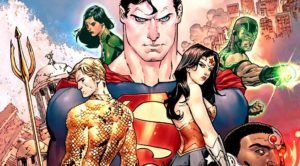International Iron Man 1
Marvel Comics, May 2016
Writer: Brian Michael Bendis
Review by DG Stewart, 9 April 2016
This title has been promoted both by its cover art and in marketing copy as having an espionage flavour to it. There is little evidence of that in this first issue aside from a flashback action scene. Instead, it is almost certainly the most interesting Iron Man concept to come from its US publisher, Marvel Comics, since British writer Warren Ellis’ work on the “Extremis” story in 2005-2006.
Marvel Comics’ property Iron Man has been long portrayed as both a billionaire industrialist, and as a gifted inventor who has created a series of weaponised mechanical suits. There has been repeated a updating of Iron Man’s origin by Marvel Comics over the years (the character’s spark of inspiration to build a mechanised suit of armour came when as a hostage of the Viet Cong during the Vietnam War). The character was depicted during the 1980s as struggling with alcoholism, has had a succession of unsuccessful relationships, and has been replaced in his persona as Iron Man on many occasions. Iron Man is a foundation member of Marvel Comics’ premier superhero ensemble called “The Avengers”, has saved the world countless times, and a few years ago was depicted as Secretary of Defence in the US government. But the fictional life before the kidnapping event which caused the title character of this series to become Iron Man has been a void, until now.
Much of this first issue is a flashback, to when Iron Man (whose real name is Tony Stark) was an undergraduate “twenty years ago” at Cambridge University in England. World Comic Book Review does not ordinarily critique the art in comic books because we have no expertise to do so and, further, art is very subjective subject matter in terms of its aesthetics. But on this occasion we acknowledge the role of artist Alex Maleev in providing us with an image of Tony Stark in around 1996. As your aged correspondent can attest from experience, the rendition of Tony Stark is perfectly captured. It would be no stretch to observe this youthful Tony Stark listening to songs from Rage Against The Machine or Stone Temple Pilots on his Discman. Except, of course, Stark is the heir to the fortune of Stark Industries and in this story confesses to holding various patents in his own name, before graduating from college. The patents are commercialised and are the source of his income in circumstances where he is estranged from his billionaire father.
Brian Micheal Bendis is a comic book writer with a formidable reputation in characterisation. Readers of this comic are treated to the fullest extent of Mr Bendis’ skills. Within this comic’s scant twenty-one pages we learn that the youthful Tony Stark is wry, bitter, witty, and brave. Charm is as yet a nascent skill, but at what must be one of the most awkward dinner parties ever depicted in a comic (leaving aside Tim Minchin’ “Storm”), he holds his own.
Stark wants to spend time with a pretty, unattainable girl who is shadowed by bodyguards: he intentionally allows himself to be tasered by one of them. Overnight the bodyguard learns that Stark’s father supplies weapons to governments and the next day apologises to Stark and allows him to sit near the girl. Stark makes a sacrifice to achieve an objective with the calculated skill of a chess master.
The characterisation is not limited exclusively to the depiction of Stark. The girl’s mother makes an assessment of Stark within three panels, demonstrating that she is clever, capable of recognising character attributes that she likes, and warming to them. The girl’s father is painted as an arrogant oaf. The lecturer of Stark’s economics class delivers his diatribe on the laziness of the class with droll frustration.
At the crescendo of the flashback Tony Stark and his dinner companions are ambushed by agents of Hydra (a perennial threat in Marvel Comics’ continuity). Things become very grim very rapidly.
Stark does not have the armour, is not an Avenger, and has never saved the world. But, upon seeing one of his companions on the verge of being executed, he takes a gun from a downed Hydra agent and shoots another in the head. There is no bravado or combat finesse associated with this. The youthful Stark looks stunned by what he has had to do, and the reader gets the impression that the shot was as fortunate as it was lethal. Stark is then shot in the shoulder, and saved by, perhaps, another lucky aim.
Cassandra Gillespie, a fellow student at Cambridge, is the girl being pursued by Stark. Upon their first discussion the two are very attracted to each other on a level beyond the physical. As it evolves, she is the daughter of Stark’s father’s business rival. In the confrontation with Hydra, Stark saves Gillespie’s mother, takes a bullet as a consequence, and Gillespie saves Stark. The stresses of the event and the blood debts arising from this manifest at the very last page, post-flashback: an aged Gillespie reveals herself as being behind armoured goons who have trounced Iron Man at the very first page. But Iron Man cannot fight a woman who was there at his inception as a man, and who saved his life just as he saved the life of her mother. The relationship between the two is deep and complex.
All of this was achieved within a single issue. Mr Bendis is at his best in this title.

